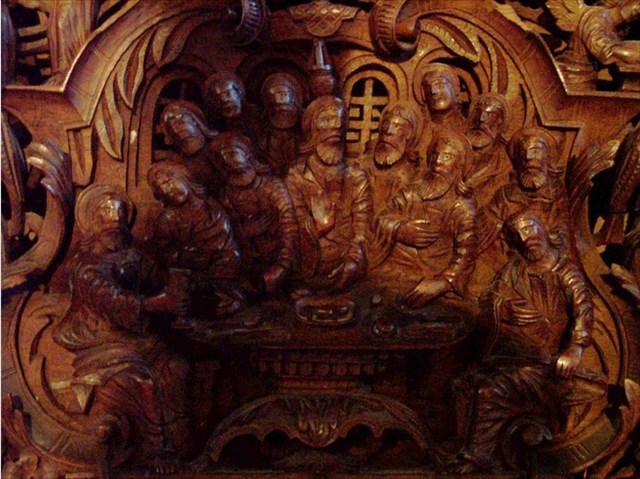The iconostasis is divided into six horizontal belts. The first one's base is comprised of rectangular fields on which there are ornaments of flora and fauna. The second belt, where throne (big and non-movable) icons are placed, finishes with a figure of an eagle with spread wings. The third belt is divided into three smaller horizontal compartments where symmetrically distributed angels, grapes and vineyard sprouts are presented. There are two rows of icons- festive (icons that are being taken out for festivities) and icons with presentation of angels above them . In the central part there is the large cross with the Crucifixion of Christ. From both sides of the cross there are figures of dragon from whose mouth the icons of St. Jovan and Holy Mother of God are lifted. The presentation of the dancer Salome is particularly interesting, she is dressed in a traditional Miyak costume. In total, the iconostasis have over 200 human figures and 500 animals.

The monastery is also famous for the Icon of "Sv. Jovan Krstitel" (St. John the Baptist) which is believed to have a mysterious power. The Icon was found by the monarch Jovan in the year of 1020, on the same place where the Monastery was built later on, and it was floating over the river Radika. In the XVIth century, under the Turkish ruler Selim II, Turks burned the Monastery and the Icon mysteriously disappeared and returned later, again un-harmed, to the same place. The Icon of Sv. Jovan Bigorski was not protected for 35 years and finally in the year of 1885 was framed in silver (it is written in the Monastery record files). Jovan Krstitel is represented in the Icon as a three- handed Saint. It is believed that the third hand is blessed, and also helps families who can't have children. There is a story about this legend, and it follows:
A Beg (Bey) from Albania who couldn't have children, came to the monastery in the XVIth century to worship the Icon. Next Year he had a son, and he donated all his property to "Sv. Jovan". He promised that he would send olive oil to the monastery (he was producing olive oil).
The old mansions with the spacious wooden balconies and the dining room furnished with authentic furniture from the time of the construction, late XVIIth and early XlXth century, add to the monastery's ambient.
Today four monks and three novices form the brotherhood of this monastery. Their abbot, archmandrite Parthenius has learnt the basics of the monastic life at the Holy Mount of Athos.
As of recently, the Bigorski monastery houses a beautiful Icon gallery. The gallery currently features 70 out of the 160 planned icons, dating from the XVII, XVIII and XIX century. All of the icons are property of the Monastery.
The gallery is to be updated with the rest of the monastery icons currently being conserved, two priest robes as well as with elements from the old iconostasis (XVII century).
Most of the old monastery complex was burnt down in 2009, while the new sections of the complex and church were saved. Reconstruction of the old palaces begun in May 2010 with the aim to reconstruct it as authentic as possible.
Reconstruction works

This incredible Monastery can be reached from the two directions: from the city of Struga, or from Mavrovi Anovi village (at Mavrovo Lake). At the site R1 is turning up toward the monastery. The asphalt road after few hundred meters leads you to the Monastery, where is a parking. The monastery has self-catering dormitories where you can stay overnight.
Please, wear decent clothes.
The wall with the cache

The cache is a small plastic film container.
Sources: Wikipedia, other internet sources. Photos: Internet and original (by Galejnik)